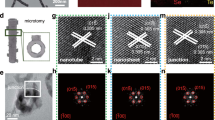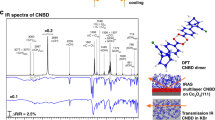Abstract
Large-scale utilization of solar-energy resources will require considerable advances in energy-storage technologies to meet ever-increasing global energy demands. Other than liquid fuels, existing energy-storage materials do not provide the requisite combination of high energy density, high stability, easy handling, transportability and low cost. New hybrid solar thermal fuels, composed of photoswitchable molecules on rigid, low-mass nanostructures, transcend the physical limitations of molecular solar thermal fuels by introducing local sterically constrained environments in which interactions between chromophores can be tuned. We demonstrate this principle of a hybrid solar thermal fuel using azobenzene-functionalized carbon nanotubes. We show that, on composite bundling, the amount of energy stored per azobenzene more than doubles from 58 to 120 kJ mol–1, and the material also maintains robust cyclability and stability. Our results demonstrate that solar thermal fuels composed of molecule–nanostructure hybrids can exhibit significantly enhanced energy-storage capabilities through the generation of template-enforced steric strain.
This is a preview of subscription content, access via your institution
Access options
Subscribe to this journal
Receive 12 print issues and online access
$259.00 per year
only $21.58 per issue
Buy this article
- Purchase on Springer Link
- Instant access to full article PDF
Prices may be subject to local taxes which are calculated during checkout





Similar content being viewed by others
References
Cook, T. R. et al. Solar energy supply and storage for the legacy and nonlegacy worlds. Chem. Rev. 110, 6474–6502 (2010).
Aricò, A. S., Bruce, P., Scrosati, B., Tarascon, J-M. & van Schalkwijk, W. Nanostructured materials for advanced energy conversion and storage devices. Nature Mater. 4, 366–377 (2005).
Dunn, B., Kamath, H. & Tarascon, J-M. Electrical energy storage for the grid: a battery of choices. Science 334, 928–935 (2011).
Reece, S. Y. et al. Wireless solar water splitting using silicon-based semiconductors and earth-abundant catalysts. Science 334, 645–648 (2011).
Nocera, D. G. The artificial leaf. Acc. Chem. Res. 45, 767–776 (2012).
Benson, E. E., Kubiak, C. P., Sathrum, A. J. & Smieja, J. M. Electrocatalytic and homogeneous approaches to conversion of CO2 to liquid fuels. Chem. Soc. Rev. 38, 89–99 (2008).
Matthews, H. D. & Solomon, S. Irreversible does not mean unavoidable. Science 340, 438–439 (2013).
Gur, I., Sawyer, K. & Prasher, R. Searching for a better thermal battery. Science 335, 1454–1455 (2012).
Kucharski, T. J., Tian, Y., Akbulatov, S. & Boulatov, R. Chemical solutions for the closed-cycle storage of solar energy. Energy Environ. Sci. 4, 4449–4472 (2011).
Bren’, V. A., Dubonosov, A. D., Minkin, V. I. & Chernoivanov, V. A. Norbornadiene–quadricyclane—an effective molecular system for the storage of solar energy. Russ. Chem. Rev. 60, 451–469 (1991).
Zen-ichi, Y. New molecular energy storage systems. J. Photochem. 29, 27–40 (1985).
Scharf, H-D. et al. Criteria for the efficiency, stability, and capacity of abiotic photochemical solar energy storage systems. Angew. Chem. Int. Ed. Engl. 18, 652–662 (1979).
Jones G. II, Chiang, S-H. & Xuan, P. T. Energy storage in organic photoisomers. J. Photochem. 10, 1–18 (1979).
Dubonosov, A. D., Bren, V. A. & Chernoivanov, V. A. Norbornadiene–quadricyclane as an abiotic system for the storage of solar energy. Russ. Chem. Rev. 71, 917–927 (2002).
Boese, R. et al. Photochemistry of (fulvalene)tetracarbonyldiruthenium and its derivatives: efficient light energy storage devices. J. Am. Chem. Soc. 119, 6757–6773 (1997).
Kanai, Y., Srinivasan, V., Meier, S. K., Vollhardt, K. P. C. & Grossman, J. C. Mechanism of thermal reversal of the (fulvalene)tetracarbonyldiruthenium photoisomerization: toward molecular solar–thermal energy storage. Angew. Chem. Int. Ed. 49, 8926–8929 (2010).
Moth-Poulsen, K. et al. Molecular solar thermal (MOST) energy storage and release system. Energy Environ. Sci. 5, 8534–8537 (2012).
Hou, Z. et al. Switching from Ru to Fe: picosecond IR spectroscopic investigation of the potential of the (fulvalene)tetracarbonyldiiron frame for molecular solar-thermal storage. Phys. Chem. Chem. Phys. 15, 7466–7469 (2013).
Kolpak, A. M. & Grossman, J. C. Azobenzene-functionalized carbon nanotubes as high-energy density solar thermal fuels. Nano Lett. 11, 3156–3162 (2011).
Kolpak, A. M. & Grossman, J. C. Hybrid chromophore/template nanostructures: a customizable platform material for solar energy storage and conversion. J. Chem. Phys. 138, 034303 (2013).
Dyke, C. A. & Tour, J. M. Covalent functionalization of single-walled carbon nanotubes for materials applications. J. Phys. Chem. A 108, 11151–11159 (2004).
Tasis, D., Tagmatarchis, N., Bianco, A. & Prato, M. Chemistry of carbon nanotubes. Chem. Rev. 106, 1105–1136 (2006).
Feng, W., Luo, W. & Feng, Y. Photo-responsive carbon nanomaterials functionalized by azobenzene moieties: structures, properties and application. Nanoscale 4, 6118–6134 (2012).
Ying, Y., Saini, R. K., Liang, F., Sadana, A. K. & Billups, W. E. Functionalization of carbon nanotubes by free radicals. Org. Lett. 5, 1471–1473 (2003).
Fujino, T., Arzhantsev, S. Y. & Tahara, T. Femtosecond time-resolved fluorescence study of photoisomerization of trans-azobenzene. J. Phys. Chem. A 105, 8123–8129 (2001).
Han, M. & Hara, M. Intense fluorescence from light-driven self-assembled aggregates of nonionic azobenzene derivative. J. Am. Chem. Soc. 127, 10951–10955 (2005).
Han, M. R. & Hara, M. Chain length-dependent photoinduced formation of azobenzene aggregates. New J. Chem. 30, 223–227 (2006).
Han, M., Ishikawa, D., Muto, E. & Hara, M. Isomerization and fluorescence characteristics of sterically hindered azobenzene derivatives. J. Lumin. 129, 1163–1168 (2009).
Kuhn, H. J., Braslavsky, S. E. & Schmidt, R. Chemical actinometry (IUPAC technical report). Pure Appl. Chem. 76, 2105–2146 (2004).
Acknowledgements
The authors acknowledge financial support from BP for a BP-MIT Postdoctoral Research Associateship (T.J.K.) and research funds awarded through the MIT Energy Initiative, which supported the synthesis of functionalized SWCNTs, and the Advanced Research Projects Agency-Energy (ARPA-E), US Department of Energy, under Award Number DE-AR0000180, which supported all other work. Calculations were performed at the National Energy Research Scientific Computing Center, supported by the Office of Science of the U.S. Department of Energy under Contract No. DE-AC02-05CH11231.
Author information
Authors and Affiliations
Contributions
T.J.K. synthesized the materials and performed experiments, N.F. performed solid-state fluorescence and spectroscopy measurements, A.M.K. performed DFT calculations and J.O.Z. performed experiments. All authors contributed to the experimental design, analysed the data and wrote the paper.
Corresponding authors
Ethics declarations
Competing interests
The authors declare no competing financial interests.
Supplementary information
Supplementary information
Supplementary information (PDF 1827 kb)
Rights and permissions
About this article
Cite this article
Kucharski, T., Ferralis, N., Kolpak, A. et al. Templated assembly of photoswitches significantly increases the energy-storage capacity of solar thermal fuels. Nature Chem 6, 441–447 (2014). https://doi.org/10.1038/nchem.1918
Received:
Accepted:
Published:
Issue Date:
DOI: https://doi.org/10.1038/nchem.1918
This article is cited by
-
A new approach exploiting thermally activated delayed fluorescence molecules to optimize solar thermal energy storage
Nature Communications (2022)
-
Azobenzene-Based Solar Thermal Fuels: A Review
Nano-Micro Letters (2022)
-
A quantum study on novel azo-dyes containing a fullerene C60 unit as a smart material for optoelectronic applications
Journal of Molecular Modeling (2020)
-
Photo-Isomerization Energy Storage Using Azobenzene and Nanoscale Templates: A Topical Review
Journal of Thermal Science (2020)
-
A High Energy Density Azobenzene/Graphene Oxide Hybrid with Weak Nonbonding Interactions for Solar Thermal Storage
Scientific Reports (2019)



